
文章信息
- 刘淑雅, 陈楠生. 2021.
- LIU Shu-ya, CHEN Nan-sheng. 2021.
- 胶州湾海域浮游植物和赤潮物种的生物多样性研究进展
- Advances in biodiversity analysis of phytoplankton and harmful algal bloom species in the Jiaozhou Bay
- 海洋科学, 45(4): 170-188
- Marine Sciences, 45(4): 170-188.
- http://dx.doi.org/10.11759/hykx20201021003
-
文章历史
- 收稿日期:2020-10-21
- 修回日期:2020-11-19
2. 青岛海洋科学与技术试点国家实验室 海洋生态与环境科学功能实验室, 山东 青岛 266237;
3. 中国科学院海洋大科学研究中心, 山东 青岛 266071
2. Laboratory of Marine Ecology and Environmental Science, Qingdao National Laboratory for Marine Science and Technology, Qingdao 266237, China;
3. Center for Ocean Mega-Science, Chinese Academy of Sciences, Qingdao 266071, China
赤潮(Red tide)是一种由海洋藻类、原生动物或细菌在水体中过度繁殖或聚集导致海水变色的全球性海洋生态异常现象, 目前国际上更多称其为有害藻华(harmful algal blooms, HABs)[1]。由于人类活动和气候变化的双重影响, 我国赤潮频发, 对近海海域生态系统、水产养殖业和旅游业造成了巨大的经济损失[2]。近年来, 赤潮呈现出暴发规模增大、持续时间更长、致灾效应加重、全球扩张、赤潮原因种多样化和小型化的演变趋势[3-4]。赤潮是浮游植物群落演替的一种极端结果, 而浮游植物种类繁多, 受环境因子变化的影响显著, 同时其动态变化直接影响到生态系统的结构与功能, 因此通过航次调查分析包括赤潮物种在内的浮游植物组成的多样性和时空动态分布, 对研究赤潮暴发形成的原因和机理机制至关重要。
胶州湾位于山东半岛南部和黄海西岸(图 1), 平均水深7 m, 其四周为青岛市、胶州市和胶南市所包围, 沿岸一带港口航运、滨海旅游和渔业生产发达, 是一个受自然变化与人类活动双重影响极为显著的典型半封闭海湾[5]。胶州湾是我国温带地区典型的陆架浅海海湾, 既具半封闭海湾系统的特点, 又与南黄海保持一定强度的生物和水体交换。
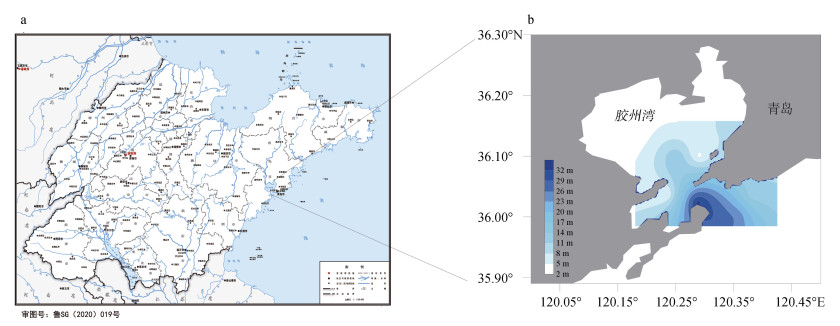 |
| 图 1 胶州湾海域的地理位置 Fig. 1 Geographical location of the Jiaozhou Bay |
赤潮暴发既取决于海域赤潮生物的多样性, 也取决于该海域包括温度、盐度、营养盐、潮流和径流等环境因子的双重作用[6-7]。胶州湾位于北温带季风气候区, 夏季受到副热带高压控制, 温暖潮湿, 降水充沛, 冬季常有冷空气来袭, 遭遇大风降温天气[8]。胶州湾海域水温分布和变化具有明显的季节特征, 最低水温出现在1月份(2.9 ℃), 最高在9月份(25.5 ℃)[9]。台风等异常天气导致的强降水对胶州湾浮游植物群落产生较大影响, 暴雨后浮游硅藻优势物种组成发生改变, 物种数则显著下降, 浮游硅藻平面分布也发生变化[10]。胶州湾海水的基本运动主要是外来潮波引起的潮汐运动, 潮汐类型判别值(即月球和太阳合成日分潮K1和主要月球日分潮O1的振幅之和除以主要月球半日分潮M2的振幅)均在0.4左右, 属于正规半日潮, 潮汐类型稳定, 平均潮差约为2.8 m[8, 11]。潮汐是影响沿岸水体稳定度的重要因子, 高潮期间浮游植物的生长明显受到水交换的影响, 细胞数量比较低, 而小潮期间浮游植物细胞数量则有明显增长的趋势, 浮游植物组成和水体稳定性共同决定了夏季赤潮的发生[12]。
营养盐是生态系统的基础物质, 其分布和结构直接影响浮游植物群落结构, 进而影响整个生态系统生物资源的可持续利用。环抱胶州湾的青岛市区域内有白沙河、大沽河、海泊河、洋河、板桥坊河、李村河、墨水河、湾头河和楼山河等十多条河流向胶州湾汇入[13]。随着人口增加和经济活动规模展开, 胶州湾成为沿湾各种污水及污染物的主要纳污海域, 富营养化水平不断升高, 导致浮游植物种类和数量都发生了较大变化, 这为赤潮的形成与发展提供了丰富的物质基础[14-15]。孙晓霞等系统分析了1962-2008年间胶州湾营养盐浓度与结构的变化规律, 发现几十年来胶州湾各项营养盐浓度都呈现增加趋势, 富营养化程度逐渐加重[16]。王艳玲等研究了胶州湾海域的富营养化水平, 发现2010年胶州湾富营养化严重的海域主要集中在胶州湾东北角及北部海域, 呈现由北向南逐渐减轻的趋势[17]。高磊等研究对比发现近年来胶州湾各项营养盐增加速率发生变化, 无机氮增加速率变缓, 磷酸盐呈现下降趋势, 硅酸盐增加幅度变大, 营养盐限制由硅限制逐步转为磷限制[18]。研究也有发现硅酸盐对浮游植物群落组成具有较大的影响, 研究者在20世纪90年代以来的多次调查中发现胶州湾的初级生产力在夏季最高, 在冬末初春最低, 而这也正是硅酸盐含量的低值期[19-20]。Shen等认为硅酸盐可能是胶州湾硅藻赤潮暴发的主要因素[21]。
综上, 影响胶州湾海域赤潮暴发因素众多, 本文从胶州湾海域浮游植物群落, 特别是赤潮物种入手, 系统综述胶州湾海域浮游植物和赤潮物种生物多样性的研究进展, 为赤潮暴发预警和暴发机制研究提供本底资料。
1 胶州湾海域的历史航次调查及研究方法发展研究与我国的其他海域相比, 针对胶州湾海域浮游植物的研究开始得比较早, 历史调查较多, 积累了丰富的历史资料。本文综述了1936-2019年间涉及浮游植物的54个航次调查结果(表 1,附表 1; 图 2)。据文献记载, 胶州湾及其附近海域浮游植物的研究最早可追溯到1936年, 金德祥等对青岛海域硅藻进行了8个月的观测[22-23]。此后李冠国等[24]、钱树本等[25]和郭玉洁[26]等对胶州湾进一步调查, 均以网采(> 76 m)的方法进行调查。进入20世纪90年代以后, 胶州湾海域浮游植物调查频次增加, 代表性调查包括陈碧鹃等[27]、焦念志等[28]、刘东艳等[29]和吴玉霖等[14]。胶州湾浮游植物群落演替的长周期变化研究开展比较晚, 吴玉霖等[14]对1953-1956年、1981年、1991-1995年和1997-2004年连续多年季度性拖网采集的浮游植物样品分析, 探讨了环境长期变化对胶州湾浮游植物群落结构的影响, 发现浮游植物物种数量呈增加趋势, 但Shannon-Wiener指数有所下降, 优势种更替明显, 表明物种分布均匀度降低。孙晓霞等[30]也发现了相似的规律, 自1981年至2008年, 胶州湾浮游植物总量呈现增加的趋势, 但空间分布格局没有发生明显改变, 优势浮游植物组成发生改变。

|
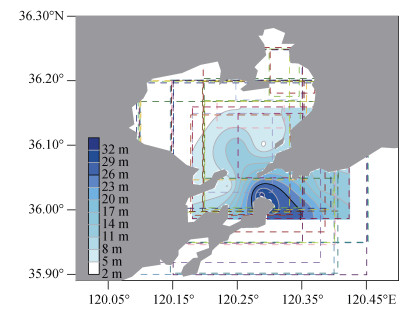 |
| 图 2 胶州湾海域的航次调查范围 Fig. 2 Sampling areas covered by expeditions in the Jiaozhou Bay |
针对胶州湾沉积物中浮游植物的研究也有进展, 刘东艳[23]对胶州湾沉积物柱样(1899-2001年)的硅藻研究, 共鉴定出96种硅藻, 其中圆筛藻科和舟形藻目是构成胶州湾沉积物中硅藻的主要类群。李影等[31]研究了胶州湾表层沉积物中甲藻孢囊的分布, 共鉴定甲藻孢囊37种和2种未定种。
针对胶州湾海域浮游植物的研究方法也在不断改进, 最常规的方法是对采集的样品进行固定, 使用显微观察和计数。其中绝大多数研究使用网采的方法收集样品[14, 32], 但我国网采样品中使用的网具孔径多为76 μm, 拖网过程中细胞个体较小的物种容易漏掉。Wen等[33]、杨世民等[34-35]和石晓勇等[36]等通过水样分析的方法, 对所有粒径的究浮游植物群落进行分析。光学显微镜方法观察能够全面的反映浮游植物的种类组成, 但是存在很多缺点: 水样中的杂质干扰鉴定, 有些微藻细胞比较脆弱难以固定, 对10 μm以下的物种、寄生性浮游植物和隐存种难以通过形态观察进行鉴定[37-38]。随着检测技术的发展, 流式细胞技术[39]和基于诊断色素分析方法[40]对胶州湾浮游植物类群展开研究, 但流式细胞技术和依赖生理生化指标技术对微藻的分辨很难达到种水平, 应用也受到了较大限制[41-42]。
分子生物学技术方法的应用极大地促进了胶州湾的浮游植物研究。刘永健等[43]对胶州湾浮游植物总DNA扩增了核酮糖1, 5-二磷酸羧化/氧化酶大亚基(rbcL)基因片段进行克隆测序, 比较分析了不同季节的浮游植物群落组成。2019年, 我们实验室首次利用基于扩增序列变异(amplicon sequence variants, ASVs)的宏条形码方法(metabarcoding technique)对胶州湾海域浮游植物群落进行分析, 鉴定到了70个新藻类物种[44]。针对胶州湾分离单细胞的研究也在陆续展开, 殷明焱等[45]对胶州湾有毒藻华形成种里氏金色藻(Chrysochromulina leadbeateri)进行分类学研究, 发现该种为我国的新记录种。翟䜣宇等[46]对胶州湾海域的赤潮物种多环马格里夫藻(Margalefidinium polykrikoides)进行分离研究。Hu等[47]和Lin等[48]等分离M. fulvescens进行了形态和遗传多样性研究。
2 胶州湾海域的浮游植物研究 2.1 胶州湾海域浮游植物统计与比较分析根据发表文献, 本文统计了过去84年间在胶州湾海域鉴定的549个浮游植物, 包括54个物种未定到种水平的物种(附表 2)。549个浮游植物属于12个门, 分别是硅藻326种、甲藻164种、绿藻21种、金藻9种、隐藻9种、淡色藻6种、定鞭藻5种、蓝藻3种、黄藻3种、下睫虫2种、裸藻1种和针胞藻1种(图 3a)。其中硅藻的物种数目最多, 高达59.38%, 其次是甲藻, 占比为29.87%。
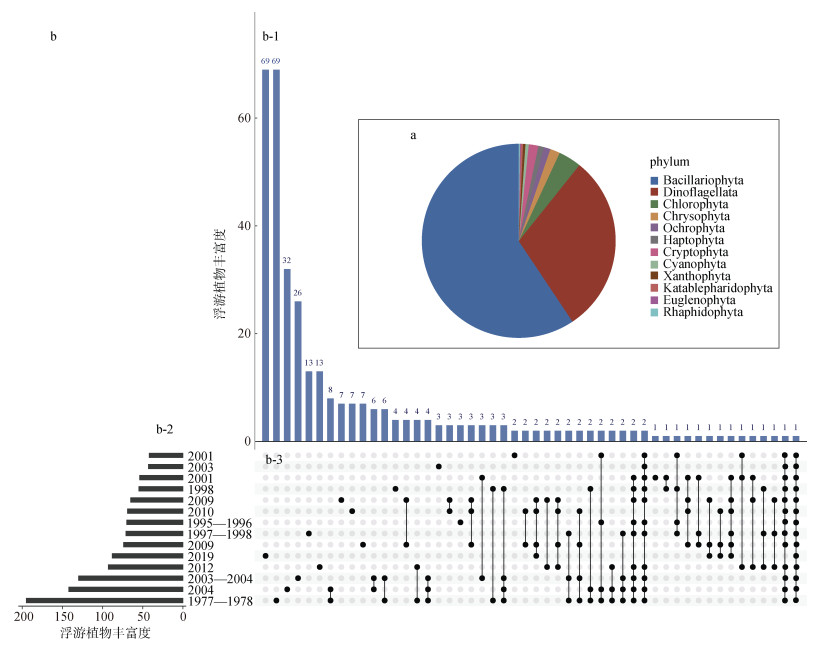 |
| 图 3 胶州湾海域航次调查鉴定出的浮游植物比较分析 Fig. 3 Comparative analysis of phytoplankton identified in previous expeditions in the Jiaozhou Bay 注: a: 浮游植物在门水平的分布; b: 胶州湾海域不同航次统计到的浮游植物的比较分析。b-1: 柱状图是不同年份调查组合共有的浮游植物数(只展示了前50个组合); b-2: 直方图是不同年份航次调查出的浮游植物数; b-3: 点线图是与上方柱状图对应的不同年份调查组合 |
为了比较浮游植物物种组成的历史变化, 我们对54个调查数据进行整理, 并重点分析了有代表性(即没有明显偏好性)的14个航次调查结果(图 3b)。有些航次具有明显的偏好性, 具有针对性目的, 并没有对所有浮游植物进行调查; 另外有些调查虽然没有偏好性, 但相应的文章中只重点介绍了优势物种。针对这14个代表性航次调查结果的研究发现, 不同航次报道的物种数目相差较大, 浮游植物物种的相似度不高, 只有短角弯角藻(Eucampia zodiacus)这一个赤潮硅藻物种在所有航次中均检测到。在1977-1978年[25]和2019年[44]的航次分辨出较多的物种, 检测到69个独有物种。1977-1978年胶州湾海域浮游植物群落与其他航次组成相差较大, 可能与当时营养盐水平较低有关[16], 显示浮游植物群落的历史变迁, 也可能反映了采样方法等技术差异。利用宏条形码技术通过对2019年航次中0.2~10 μm尺寸范围内的浮游植物进行研究, 我们还发现了较多在以前航次调查中没有描述的个体比较小的物种和隐存种。
历史航次调查中, 胶州湾海域优势浮游植物(在所有航次调查中的出现频率 > 2)有37种, 其中硅藻34个, 甲藻2个和针胞藻1个, 如图 4所示。出现频率最高的浮游植物被认为是中肋骨条藻(Skeletonema costatum), 其次是旋链角毛藻(Chaetoceros curvisetus)、短角弯角藻、加氏星杆藻(Asterionella kariana)、日本星杆藻(A. j aponica)、星脐圆筛藻(Coscinodiscus asteromphalus)和尖刺拟菱形藻(Pseudo-nitzschia pungens), 这些优势物种均为赤潮物种(如图 4所示)。刘东艳[23]通过对1936-2004年近70年调查的统计分析, 发现胶州湾海域优势物种呈现出明显的演替现象, 冕孢角毛藻(C. subsecundus)、奇异角毛藻(C. paradoxus)、刚毛根管藻(Rhizosolenia setigera)的优势地位己经被取代, 赤潮物种中肋骨条藻、尖刺菱形藻(Nitzschia pungens)、新月菱形藻(N. closterium)、短角弯角藻和诺登海链藻(Thalassiosira nordenskioeldii)等数量大且持续时间较长。孙晓霞等[30]对1981-2008年胶州湾浮游植物调查发现, 自1981年来胶州湾浮游植物的优势物种浮游植物优势种组成发生变化, 在20世纪90年代之前占据优势地位的斯氏几内亚藻(Guinardia striata)、印度翼根管藻(R. alata f. indica)和中华半管藻(Hemiaulus sinensis)等种类在2000年之后不再占优势。除了一直居优势地位的中肋骨条藻、旋链角毛藻、星脐圆筛藻、柔弱角毛藻(C. debilis)、尖刺拟菱形藻和短角弯角藻等之外, 洛氏角毛藻(C. lorenzianus)、密连角毛藻(C. densus)、波状石鼓藻(Lithodesmium undulatum)、叉角藻(Ceratium furca)和梭角藻(C. fusus)等成为新的优势种。罗璇等[32]则发现2011年胶州湾全年占优势的种类和2004-2008年的调查结果相似, 主要有中肋骨条藻和角毛藻; 尖刺拟菱形藻和派格棍形藻(Bacillaria paxillifera)虽然在全年频繁出现, 但优势度很低。日本星杆藻在是胶州湾海域的优势种群, 但是在2000s后失去了优势地位[49]。
 |
| 图 4 胶州湾海域航次调查鉴定出的优势浮游植物(出现频次 > 1) Fig. 4 Dominant phytoplankton reported in the Jiaozhou Bay in historical expeditions 注: a: 柱状图; b: 词云图 |
目前关于胶州湾浮游植物群落已有较多研究, 采用的方法主要是网采或者水样分析, 根据传统形态学特征进行鉴定和计数。利用分子生物学技术来定性和定量分析浮游植物已经成为一种趋势, 是对传统浮游植物分析方法的重要补充, 其中宏条形码技术是以特定生境中的微生物群落为研究对象, 直接提取样本中的DNA, 以通用的条形码进行测序来分析环境微生物的群落结构[37]。目前应用于海洋浮游植物的宏条形码分析的分子标记比较多, 包括18S rDNA、28S rDNA、ITS、rbcL和cox1等[37]。其中18S rDNA使用得最多, 它是编码真核生物核糖体小亚基(SSU)的DNA序列, 是最早被用于真核生物分子鉴定的基因[50]。针对文献中描述过的549种胶州湾浮游植物, 我们只在数据库(NCBI)中查询到220个物种的18S rDNA全长序列, 占比40.29%, 说明有较多浮游植物物种的18S rDNA序列还没有获得解析, 还需要进一步通过分离单细胞并完成测序来丰富数据库。具有全长18S rDNA序列的浮游植物220个物种(图 5b-c)中, 硅藻117种, 甲藻66种, 绿藻14种, 隐藻6种, 淡色藻5种, 定鞭藻4种, 金藻3种, 黄藻2种, 下睫虫2种和针胞藻1种。文献统计结果与我们2019年的宏条形码分析结果有些发现类似。宏条形码分析得到326个浮游植物ASVs, 其中只有166个ASVs在数据库中有对应的浮游植物物种, 注释到种的水平[44]。因此, 进一步分离和解析胶州湾浮游植物的分子标记序列也有助于解读宏条形码分析的结果。
 |
| 图 5 胶州湾海域航次调查鉴定出的浮游植物 Fig. 5 Phytoplankton identified in previous expeditions in the Jiaozhou Bay 注: a: 是否具有全长18S rDNA(> 1600bp)的浮游植物物种数; b: 胶州湾海域航次调查鉴定出的具有全长18S rDNA(> 1600bp)的浮游植物门水平分布饼图; c: 胶州湾海域航次调查鉴定出的具有全长18S rDNA(> 1600bp)的浮游植物构建系统进化树 |
本文利用文献中报道的浮游植物鉴定结果对胶州湾浮游植物群落结构组成中的两大组成成分甲藻和硅藻的历史变化进行了比较研究。根据以往的文献报道, 胶州湾水域浮游植物的种类组成和细胞丰度上以硅藻为主[14, 34], 但随着时间推移, 甲藻与硅藻细胞数量的比值发生变化, 甲藻在群落中比重增加, 而硅藻在群落中的比重下降, 并且甲藻Prorocentrum gracile和扁平原多甲藻在部分月份成为优势物种[23]。孙晓霞等[30]对1981-2008年胶州湾海域浮游植物近30年的研究发现, 叉角藻与梭角藻等成为新的优势种, 甲藻类浮游植物数量升高和分布范围扩大。在2008年6月份胶州湾跨海大桥附近海域暴发了异帽藻(Heterocapsa sp.)赤潮, 表明甲藻占据较高的优势[51]。郑珊等[52]研究发现更多的甲藻种类作为优势种出现, 如扁平多甲藻(Peridinium depressum)和角藻。
为了验证这一假设, 我们比较分析了文献中报道的不同航次的甲藻与硅藻物种数, 发现甲藻与硅藻物种数并未表现出显著的变化趋势(图 6a-b)。由于胶州湾海域浮游植物群路组成具有明显的季节分布, 夏季甲藻数量比例明显增加[52-54], 我们以5年为时间分割段进行统计分析(图 6c)也没有发现显著的变化趋势(图 6d)。
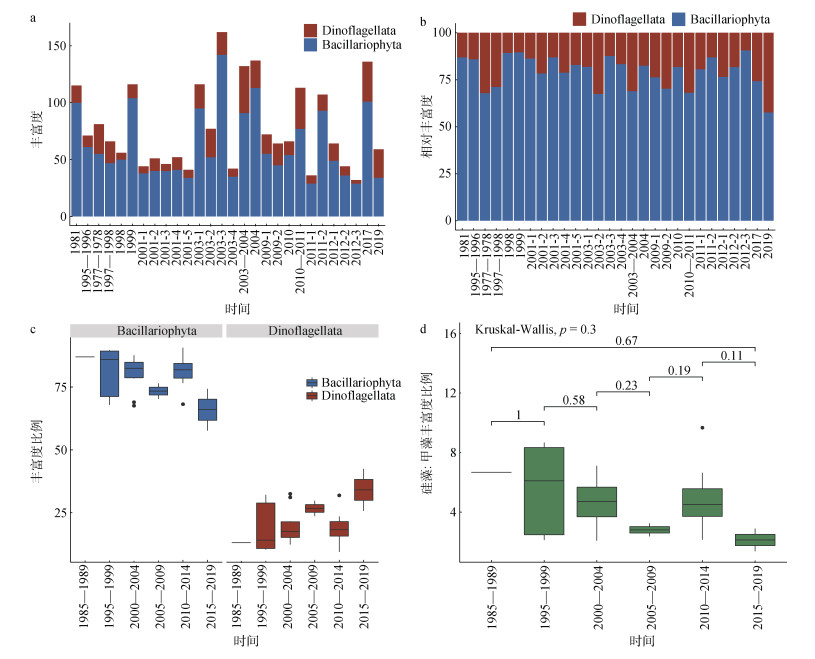 |
| 图 6 胶州湾海域中硅藻和甲藻的物种数的变化趋势分析 Fig. 6 Variation trend analysis of diatoms and dinoflagellates species recorded in previous expeditions in the Jiaozhou Bay 注: a: 硅藻和甲藻物种数目的变化; b: 硅藻和甲藻物种数目的比例变化; c: 硅藻和甲藻比例随时间(每5年)变化箱式图; d: 硅藻与甲藻比例随时间变化显著性分析, 两两比较(Wilcoxon test)和多组比较(Kruskal-Wallis) |
作为我国近海典型的海湾, 胶州湾是我国近海生态系统的缩影, 也是研究我国海域赤潮物种组成和动态变化的理想实验场所。20世纪70年代起, 我国沿海藻华发生的频率、规模和危害程度日趋严重[55], 而胶州湾首次记载是1990年暴发的由红色中缢虫引起的小范围赤潮[14]。但自90年代中期, 胶州湾赤潮迅猛发展, 暴发频率和面积也越来越大, 致灾赤潮物种也有所增加。特别是1997年以来, 不同规模的赤潮几乎连年暴发, 并有愈演愈烈的发展趋势[14]。据统计, 曾经在胶州湾海域暴发过赤潮的浮游植物有中肋骨条藻、高盒形藻(Odontella regia)、短角弯角藻、夜光藻(Noctiluca scintillans)、星脐圆筛藻、柔弱根管藻(Rhizasolenia delicatula)、诺登海链藻和异帽藻(图 7)[14, 51, 56-65]。与早期相比, 胶州湾的赤潮暴发频率有所下降, 在2000年后胶州湾海域赤潮暴发较少, 其邻近海域(如浮山湾、团岛湾和沙子口湾等)是主要暴发海域[65]。
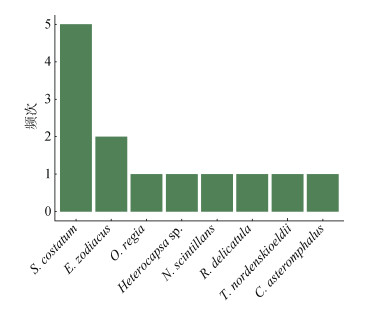 |
| 图 7 胶州湾海域赤潮暴发原因种统计直方图 Fig. 7 Bar chart of the phytoplankton species which had caused HABs in the Jiaozhou Bay |
韩笑天等[66]对胶州湾东北部富营养化海域连续跟踪监测4起赤潮发生消亡的全过程, 发现69种赤潮生物, 表明胶州湾海域存在较多的赤潮物种。我们对胶州湾航次报道过的浮游植物相关调查进行统计, 共发现153种赤潮物种(表 1; 图 8a; 附表 3), 包括硅藻79种, 甲藻67种, 定鞭藻2种, 金藻2种, 淡色藻1种, 黄藻1种和针胞藻1种。不同航次报道的赤潮物种具有较大差别, 只有1个赤潮物种(即短角弯角藻)在所有航次中都鉴定到(图 8b)。比较分析发现有2个物种报道次数最多, 分别是短角弯角藻(14次)和中肋骨条藻(13次), 是胶州湾海域的“常驻”赤潮物种。在胶州湾海域鉴定到的赤潮物种数目很高, 但是, 并非所有赤潮物种都在胶州湾暴发过赤潮。值得注意的是, 这些赤潮物种是潜在的赤潮种源, 随着环境条件的变化, 都有可能暴发赤潮。
 |
| 图 8 胶州湾海域航次调查鉴定出的赤潮物种比较分析 Fig. 8 Comparative analysis of HAB species identified in previous expeditions in the Jiaozhou Bay 注: a: 赤潮物种门水平分布饼图; b: 胶州湾海域典型航次统计到的赤潮物种分布图。b-1: 柱状图是不同年份调查组合共有的赤潮物种数(仅展示前50个组合); b-2: 直方图是不同年份航次调查出的赤潮物种数; b-3: 点线图是与上方柱状图对应的不同年份调查组合 |
胶州湾海域历史航次中优势赤潮物种出现次数最多的是中肋骨条藻, 其次是旋链角毛藻、短角弯角藻、加氏星杆藻、日本星杆藻和星脐圆筛藻和尖刺拟菱形藻(图 9), 这个与优势浮游植物分布相同, 表明胶州湾海域的常见优势浮游植物均为赤潮物种, 分布较广, 竞争力强, 有容易形成赤潮的风险。其中中肋骨条藻、短角弯角藻、星脐圆筛藻均在胶州湾暴发过赤潮[14]。
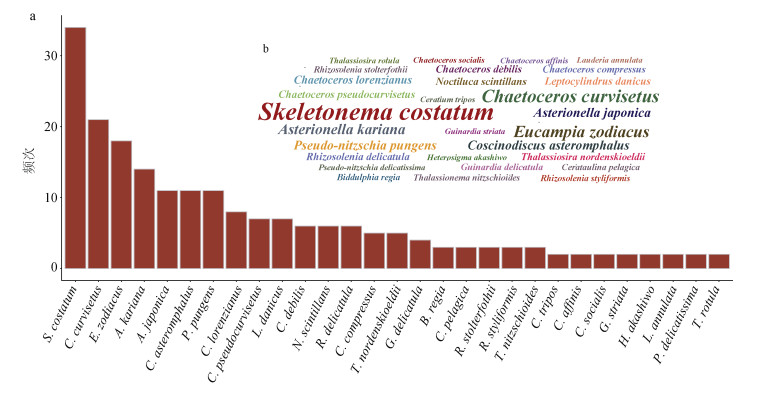 |
| 图 9 胶州湾海域航次调查鉴定出的优势赤潮物种(出现频次 > 1) Fig. 9 Dominant HAB species reported in the Jiaozhou Bay in historical expeditions 注: a柱状图; b词云图 |
骨条藻是一类在全球近岸海域广泛分布的广温广盐性浮游硅藻[67], 极易在每年的4~5月和8~9月增殖达到最高生物量。骨条藻既可以作为饵料, 也可引发赤潮, 在我国各个海域均有骨条藻所引发藻华的记录, 是我国近海常见且典型的赤潮[68-69]。骨条藻是胶州湾优势度最高的浮游植物之一, 也是胶州湾暴发赤潮频率最高的赤潮生物, 分别在1997年8月(胶州湾中部)、1998年7月(女姑山附近海域)、1999年7月(小港、团岛嘴、沧口水道)、2004年3月(胶州湾北部)和2005年8年(胶州湾大部分水域)暴发过赤潮。Sarno等[70]研究发现, 一直鉴定为中肋骨条藻的种类其实是包含玛氏骨条藻等多种骨条藻的隐存种。我国海域的骨条藻也包括多种骨条藻[68]。通过2019年1月胶州湾航次的宏条形码分析和分离到的单细胞骨条藻株系的全长18S rDNA测序分析, 我们证实胶州湾冬季的优势骨条藻为玛氏骨条藻[44]。
热带骨条藻(S. tropicum)为高温高盐种, 一般出现在热带海域和夏季的温带海域, 在福建沿海有相关报道。Liu等[71]对2009年和2010年的8月胶州湾海域中的浮游植物进行了研究, 首次在我国北方海域发现热带骨条藻。程芳晋等[69]研究发现2019年8月胶州湾海域, 热带骨条藻成为胶州湾海域的主要优势种。
3.3.2 短角弯角藻短角弯角藻, 又称浮动弯角藻, 是世界广布广温种, 细胞宽(顶轴长)为25~60 μm[61]。作为一种赤潮生物, 短角弯角藻在胶州湾海域广泛分布, 从1936年至2019年的航次调查中, 出现了34次(表 1), 仅次于中肋骨条藻。1999年短角弯角藻在胶州湾海域暴发过2次赤潮: 6月在胶州湾东北部[59, 61]和7月在胶州湾东部[58]。
3.3.3 夜光藻夜光藻, 全球主要的赤潮生物之一, 广泛分布于近岸水域和上升流海区[72]。夜光藻是一种典型的异养甲藻, 在1990s起, 成为胶州湾及其海域优势物种[14, 49]。2000年7月, 在胶州湾中部暴发过夜光藻赤潮。2012-2014年连续三年在浮山湾在暴发了小范围的夜光藻赤潮[74]。对胶州湾海域夜光藻的时空分布研究也陆续展开, 张天文等[73]在2006年8月-2007年11月进行了4次夜光藻调查, 发现胶州湾夜光藻丰度季节分布极不均衡: 春季最高, 秋季次之, 夏季最少, 并认为温度是影响其季节分布的主要因素之一。田达玮等[74]研究了于2015年逐月对胶州湾海域的夜光藻种群进行分析, 发现全年各站位夜光藻丰度范围为0~31.17×103 ind./m, 月平均丰度呈现双峰分布; 二分裂和有性繁殖均呈现出季节差异及空间差异。
3.3.4 球形异帽藻(Heterocapsa rotundata)异帽藻属是一个包含较多赤潮原因种和有毒种的甲藻[75]。在胶州湾历史调查中, 曾经有5次报道, 杨世民等[34]和杨世民等[35]分别在2009年5月和8月发现三角异帽藻(H. triquetra); Liu等[44]在2019年航次中报道球形异帽藻; 其他两次报道均没有到种的水平[23, 65]。球形异帽藻, 作为一种混合营养的甲藻, 能够捕食包括细菌在内的超微型浮游植物, 多次形成大范围赤潮[76]。球形异帽藻也是一种世界广布种, 在Chesapeake Bay(美国)、Keum Estuary(韩国)、Manim Bay(印度)、Baltic Sea(德国)和Kangaroo Island(澳大利亚)等海域有所报道[76]。
4 主要结论与展望本文通过对胶州湾海域历史航次资料的整理汇总, 主要得到以下几点结论和展望:
1) 胶州湾海域浮游植物相关调查较多, 本文综述了1936-2019年, 涉及浮游植物的航次调查54个, 共整理到549种浮游植物。胶州湾水域浮游植物的种类组成和细胞丰度上以硅藻为主, 甲藻次之, 甲藻与硅藻物种的相对数目没有发生显著的变化。
2) 胶州湾海域浮游植物分析方法也在不断发展, 最常规的方法是通过网采或者水样分析, 根据传统形态学特征进行鉴定和计数, 但对10 μm以下的物种和隐存种难以观察。基于分子生物学技术的方法, 对胶州湾的浮游植物研究也有开展。2019年首次利用宏条形码分析对胶州湾海域浮游植物群落进行分析, 鉴定到了较多新物种。根据统计分析, 胶州湾的549种浮游植物发现只有220个物种对应的18S rDNA全长序列得到解析, 说明数据库中缺失较多的浮游植物物种的全长18S rDNA数据库信息不全。进一步通过分离单细胞解析其包括18S rDNA在内的分子标记, 完善18S rDNA数据库, 是推动胶州湾浮游植物和赤潮物种生物多样性的关键。
3) 胶州湾海域赤潮频发, 赤潮物种丰富, 共鉴定153种赤潮物种, 包括硅藻79种, 甲藻67种, 定鞭藻2种, 金藻2种, 淡色藻1种, 黄藻1种和针胞藻1种。在历史航次中出现次数最多的优势浮游植物包括中肋骨条藻、旋链角毛藻、短角弯角藻、加氏星杆藻、日本星杆藻、星脐圆筛藻和尖刺拟菱形藻, 均为赤潮物种。宏条形码分析技术和分子鉴定表明, 胶州湾冬季的优势骨条藻是玛氏骨条藻, 而不是文献中报道的中肋骨条藻。
4) 只有短角弯角藻出现在均出现在关注的14个航次中(图 3和图 7), 不同航次的浮游植物和赤潮物种组成显示了很大的差异。造成这些差异的原因很多, 一方面是由于环境条件的改变, 浮游植物群落发生了较大变化; 另一方面, 不同航次的调查范围、季节、样品采集方法和监测手段等不同引起差异。因此之后的调查中, 需要采用相同的调查方法系统的长时间跟踪。宏条形码技术可以有效分辨个体比较小的物种、寄生生活的物种和隐存种, 但需要结合单细胞分离研究, 不断完善数据库, 促进宏条形码分析方法的应用。
附表 1、附表 2、附表 3见http://dx.doi.org/10.11759/hykx20200722003
| [1] |
BERDALET E, KUDELA R, URBAN E, et al. Global HAB: A new program to promote international research, observations, and modeling of harmful algal blooms in aquatic systems[J]. Oceanography, 2017, 30(1): 70-81. DOI:10.5670/oceanog.2017.111 |
| [2] |
郭皓, 丁德文, 林凤翱, 等. 近20a我国近海赤潮特点与发生规律[J]. 海洋科学进展, 2015, 33(4): 547-558. GUO Hao, DING Dewen, LIN Fengxiang, et al. Characteristics and patterns of red tide in China coastal waters during the last 20a[J]. Advances in marine science, 2015, 33(4): 547-558. DOI:10.3969/j.issn.1671-6647.2015.04.013 |
| [3] |
于仁成, 刘东艳. 我国近海藻华灾害现状、演变趋势与应对策略[J]. 中国科学院院刊, 2016, 31(10): 1167-1174. YU Rencheng, LIU Dongyan. Harmful algal blooms in the coastal waters of china: current situation, long-term changes and prevention strategies[J]. Bulletin of Chinese Academy of Sciences, 2016, 31(10): 1167-1174. |
| [4] |
俞志明, 陈楠生. 国内外赤潮的发展趋势与研究热点[J]. 海洋与湖沼, 2019, 50(3): 1-13. YU Zhiming, CHEN Nansheng. Emerging trends in red tide and major research progresses[J]. Oceanologia et Limnologia Sinica, 2019, 50(3): 1-13. |
| [5] |
孙松, 张永山, 吴玉霖, 等. 胶州湾初级生产力周年变化[J]. 海洋与湖沼, 2005, 36(6): 481-486. SUN Song, ZHANG Yongshan, WU Yulin, et al. Annual variation of primary productivity in jiaozhou bay[J]. Oceanologia et Limnologia Sinica, 2005, 36(6): 481-486. DOI:10.3321/j.issn:0029-814X.2005.06.001 |
| [6] |
ANDERSON D M, CEMBELLA A D, HALLEGRAEFF G M. Progress in understanding harmful algal blooms: paradigm shifts and new technologies for research, monitoring, and management[J]. Annual Review of Marine Science, 2012, 4(1): 143-176. DOI:10.1146/annurev-marine-120308-081121 |
| [7] |
THOMAS W H, GIBSON C H. Effects of small-scale turbulence on microalgae[J]. Journal of Applied Phycology, 1990, 2(1): 71-77. DOI:10.1007/BF02179771 |
| [8] |
展鹏. 胶州湾三维水动力及生态动力学数值模拟[D]. 山东青岛: 中国海洋大学, 2012. ZHAN Peng. Numerical simulation of hydrodynamics and eco-dynamics applied to the Jiaozhou Bay[D]. Qingdao, Shandong Province: Ocean University of China, 2012. |
| [9] |
李艳, 李瑞香, 王宗灵, 等. 胶州湾浮游植物群落结构及其变化的初步研究[J]. 海洋科学进展, 2005, 23(3): 328-334. LI Yan, LI Ruixiang, WANG Zongling, et al. A preliminary study on phytoplankton community structure and its changes in the Jiaozhou Bay[J]. Advances in Marine Science, 2005, 23(3): 328-334. DOI:10.3969/j.issn.1671-6647.2005.03.011 |
| [10] |
王为民, 陈洪举, 梁生康, 等. 夏季强降雨对胶州湾浮游硅藻群落结构的影响[J]. 海洋科学, 2014, 38(2): 46-52. WANG Weimin, CHEN Hongju, LIANG Shengkang, et al. The influence of heavy rainfall on the community structure of planktonic diatom in Jiaozhou Bay in summer[J]. Marine Sciences, 2014, 38(2): 46-52. |
| [11] |
陈斌, 张勇, 刘健, 等. 胶州湾海域潮流动力特征及其与含沙量的关系[J]. 海洋科学进展, 2012, 30(1): 24-35. CHEN Bin, ZHANG Yong, LIU Jian, et al. Tidal current dynamic characteristic and its relation with suspended sediment concentration in Jiaozhou Bay[J]. Advances in Marine Science, 2012, 30. DOI:10.3969/j.issn.1671-6647.2012.01.004 |
| [12] |
LIU D, SUN J, LIU Z, et al. The effects of spring-neap tide on the phytoplankton community development in the Jiaozhou Bay, China[J]. Acta Oceanologica Sinica, 2004, 23(4): 687-689. |
| [13] |
王修林, 李克强, 石晓勇. 胶州湾主要化学污染物海洋环境容量[M]. 北京: 科学出版社, 2006: 48-59. WANG Xiulin, LI Keqiang, SHI Xiaoyong. Marine environmental capacity of major chemical pollutants in the Jiaozhou Bay[M]. Beijing: Science Press, 2006: 48-59. |
| [14] |
吴玉霖, 孙松, 张永山. 环境长期变化对胶州湾浮游植物群落结构的影响[J]. 海洋与湖沼, 2005, 36(6): 487-498. WU Yulin, SUN Ssong, ZHANG Yonghsna. Long-term change of environment and it's influence on phytoplankton community structure in jiaozhou bay[J]. Oceanologia et Limnologia Sinica, 2005, 36(6): 487-498. DOI:10.3321/j.issn:0029-814X.2005.06.002 |
| [15] |
刘东艳, 孙军, 陈洪涛, 等. 2001年夏季胶州湾浮游植物群落结构的特征[J]. 青岛海洋大学学报, 2003, 33(3): 366-374. LIU Dongyan, SUN Jun, CHEN Hongtao, et al. The phytoplankton community in summer 2001 in Jiaozhou Bay, China[J]. Journal of Ocean University of Qingdao, 2003, 33(3): 366-374. DOI:10.3969/j.issn.1672-5174.2003.03.006 |
| [16] |
孙晓霞, 孙松, 赵增霞, 等. 胶州湾营养盐浓度与结构的长期变化[J]. 海洋与湖沼, 2011, 42(5): 662-669. SUN Xiaoxia, SUN Song, ZHAO Zengxia, et al. Long- term changes in nutrient concentration and structure in the jiaozhou bay[J]. Oceanologia et Limnologia Sinica, 2011, 42(5): 662-669. |
| [17] |
王艳玲, 安文超, 刘伟. 胶州湾海域富营养化水平与浮游植物多样性分析[J]. 环境科学与管理, 2012, 37(10): 76-79, 93. WANG Yanling, AN Wenchao, LIU Wei. Eutrophication level and phytoplankton diversity in jiaozhou bay[J]. Environmental Science and Management, 2012, 37(10): 76-79, 93. DOI:10.3969/j.issn.1673-1212.2012.10.020 |
| [18] |
高磊, 张蒙蒙, 姚海燕, 等. 近年来胶州湾营养盐结构与限制变化的探讨[J]. 海洋湖沼通报, 2018(6): 61-68. GAO Lei, ZHANG Mengmeng, YAO Haiyan, et al. An analysis of nutrient structure and limitation changes in Jiaozhou Bay in recent years[J]. Transactions of Oceanology and Limnology, 2018(6): 61-68. |
| [19] |
张均顺, 沈志良. 胶州湾营养盐结构变化的研究[J]. 海洋与湖沼, 1997, 28(5): 529-535. ZHANG Junshun, SHEN Zhiliang. A study of changes in nutrients structure of Jiaozhou Bay[J]. Oceanologia et Limnologia Sinica, 1997, 28(5): 529-535. DOI:10.3321/j.issn:0029-814X.1997.05.012 |
| [20] |
杨东方, 张经, 陈豫, 等. 营养盐限制的唯一性因子探究[J]. 海洋科学, 2001, 25(12): 49-51. YANG Dongfang, ZHANG Jing, CHEN Yu, et al. The uniquencess of nutrient limatation[J]. Marine Sciences, 2001, 25(12): 49-51. DOI:10.3969/j.issn.1000-3096.2001.12.014 |
| [21] |
SHEN Z, YAO Y, WU Y. Silica supply and diatom blooms in the Jiaozhou Bay, China[J]. Acta Oceanologica Sinica, 2016, 35(10): 20-27. DOI:10.1007/s13131-016-0917-7 |
| [22] |
金德祥, 陈金环, 黄凯歌. 中国海洋浮游硅藻类[M]. 上海: 上海科学技术出版社, 1965. JIN Dexiang, CHEN Jinhuan, HUANG Kaige. China's marine planktic diatoms[M]. Shanghai: Shanghai Science and Technology Press, 1965. |
| [23] |
刘东艳. 胶州湾浮游植物与沉积物中硅藻群落结构演替的研究[D]. 山东青岛: 中国海洋大学, 2004: 1-127. LIU Dongyan. Community structure succession study of phytoplankton and sediment diatom in Jiaozhou Bay[D]. Qingdao, Shandong Province: Ocean University of China, 2004: 1-127. |
| [24] |
李冠国, 黄世玫. 青岛近海浮游硅藻季节变化研究的初步报告[J]. 山东大学学报, 1956, 2(4): 119-143. LI Guanguo, HUANG Shimei. Seasonal variation of planktonic diatoms at tsingtao[J]. Journal of Shandong University, 1956, 2(4): 119-143. |
| [25] |
钱树本, 王筱庆, 陈国蔚. 胶州湾的浮游藻类[J]. 山东海洋学院学报, 1983, 13(1): 39-56. QIAN Shuben, WANG Youqing, CHEN Guowei. The phytoplankton of the Jiaozhou Bay[J]. Journal of Shandong College of Oceanology, 1983, 13(1): 39-56. |
| [26] |
郭玉洁. 胶州湾浮游植物[M]//刘瑞玉. 胶州湾生态学和生物资源. 北京: 科学出版社, 1992: 136-169. GUO Yujie. Phytoplankton in Jiaozhou Bay[M]//Liu Ruiyu. Ecology and biological resources of the Jiaozhou Bay. Beijing: Science Press, 1992: 136-169. |
| [27] |
陈碧鹃, 陈聚法, 袁有宪, 等. 胶州湾北部沿岸浮游植物生态特征的研究[J]. 海洋水产研究, 2000, 21(2): 34-40. CHEN Bijuan, CHEN Jufa, YUAN Youxian, et al. Study on the ecological characteristics of phytoplankton in the northern coast of Jiaozhou Bay[J]. Marine Fisheries Research, 2000, 21(2): 34-40. |
| [28] |
焦念志, 赵树江, 王勇, 等. 胶州湾营养盐结构的长期变化及其对海湾生态系统的影响[M]//焦念志等编. 海湾生态过程与持续发展. 北京: 科学出版社, 2001: 257-281. JIAO Nianzhi, ZHAO Shujiang, WANG Yong, et al. Long-term changes of nutrient structure in Jiaozhou Bay and its effects on ecosystem[M]//Jiao Nianzhi, et al., ed. Ecological process and sustainable development in the Jiaozhou Bay. Beijing: Science Press, 2001: 257-281. |
| [29] |
刘东艳, 孙军, 钱树本. 胶州湾浮游植物研究Ⅱ环境因子对浮游植物群落结构变化的影响[J]. 青岛海洋大学学报, 2002, 32(3): 415-421. LIU Dongyan, SUN Jun, QIAN Shuben. Study on the phytoplankton in Jiaozhou Bay Ⅱ: Influence of the environmental factors to phytoplankton community[J]. Journal of Ocean University of Qingdao, 2002, 32(3): 415-421. DOI:10.3969/j.issn.1672-5174.2002.03.012 |
| [30] |
孙晓霞, 孙松, 吴玉霖, 等. 胶州湾网采浮游植物群落结构的长期变化[J]. 海洋与湖沼, 2011, 42(5): 639-646. SUN Xiaoxia, SUN Song, WU Yulin, et al. Long-term changes of phytoplankton community structure in the jiaozhou bay[J]. Oceanologia et Limnologia Sinica, 2011, 42(5): 639-646. |
| [31] |
李影, 汤亚楠, 沈萍萍, 等. 胶州湾表层沉积物中甲藻孢囊的分布[J]. 海洋与湖沼, 2017, 48(4): 760-766. LI Ying, TANG Yanan, SHEN Pingping, et al. Distribution of dinoflagellate resting cysts in surface sediment of jiaozhou bay, china[J]. Oceanologia et Limnologia Sinica, 2017, 48(4): 760-766. |
| [32] |
罗璇, 孙晓霞, 郑珊, 等. 2011年胶州湾网采浮游植物群落结构及其环境影响因子[J]. 海洋与湖沼, 2016, 47(5): 915-923. LUO Xuan, SUN Xiaoxia, ZHENG Shan, et al. On phytoplankton community structure and causative factors in the jiaozhou bay in 2011[J]. Oceanologia et Limnologia Sinica, 2016, 47(5): 915-923. |
| [33] |
WEN L, SUN J, HE Q, et al. Winter phytoplankton assemblages of coastal Yellow Sea connected to Jiaozhou Bay, China[J]. Journal of Ocean University of China, 2007, 6(1): 40-46. DOI:10.1007/s11802-006-0040-7 |
| [34] |
杨世民, 王丽莎, 石晓勇. 2009年春季胶州湾浮游植物群落结构特征[J]. 海洋与湖沼, 2014, 45(6): 1234-1240. YANG Shimin, WANG Lisha, SHI Xiaoyong. Phytoplankton community of the jiaozhou bay in spring 2009[J]. Oceanologia et Limnologia Sinica, 2014, 45(6): 1234-1240. |
| [35] |
杨世民, 王丽莎, 石晓勇. 2009年夏季胶州湾同步调查浮游植物群落结构特征[J]. 海洋与湖沼, 2015, 46(1): 102-108. YANG Shimin, WANG Lisha, SHI Xiaoyong. Synchronous investigation on phytoplankton community of the jiaozhou bay in summer 2009[J]. Oceanologia et Limnologia Sinica, 2015, 46(1): 102-108. |
| [36] |
石晓勇, 王丽莎, 杨世民. 2010年冬季胶州湾浮游植物群落结构特征[J]. 海洋与湖沼, 2015, 46(2): 357-364. SHI Xiaoyong, WANG Lisha, YANG Shimin. Phytoplankton community of jiaozhou bay in winter 2010[J]. Oceanologia et Limnologia Sinica, 2015, 46(2): 357-364. |
| [37] |
陈楠生. 有害藻华的宏条形码分析: 机会与挑战[J]. 海洋科学, 2020, 44(7): 1-19. CHEN Nansheng. Metabarcoding analysis of harmful algal blooms: Opportunities and challenges[J]. Marine Sciences, 2020, 44(7): 1-19. |
| [38] |
钱奎梅, 刘霞, 陈宇炜. 淡水浮游植物计数与定量方法[J]. 湖泊科学, 2015, 27(5): 767-775. QIN Kuimei, LIU Xia, CHEN Yuwei. A review on methods of cell enumeriation and quantification of freshwater phytoplankton[J]. Journal Lake Science, 2015, 27(5): 767-775. |
| [39] |
陈芸燕, 孙晓霞, 朱明亮. 基于浮游植物流式细胞仪对胶州湾春季浮游植物的研究[J]. 海洋科学, 2017, 41(6): 72-78. CHEN Yunyan, SUN Xiaoxia, ZHU Mingliang. High- resolution analysis of Jiaozhou Bay phytoplankton community structure based on automated submerged flow cytometer during spring[J]. Marine Sciences, 2017, 41(6): 72-78. |
| [40] |
姚鹏, 于志刚, 邓春梅, 等. 基于诊断色素分析的胶州湾浮游藻功能类群研究[J]. 海洋与湖沼, 2013, 44(4): 866-876. YAO Peng, YU Zhigang, DENG Chunmei, et al. Functional types of phytoplankton in jiaozhou bay using diagnostic pigment analysis (dpa)[J]. Oceanologia et Limnologia Sinica, 2013, 44(4): 866-876. |
| [41] |
李胜男, 王秀娟, 周建, 等. 利用流式细胞仪计数微型浮游生物的方法[J]. 湖泊科学, 2015, 27(5): 757-766. LI Shengnan, WANG Xiujuan, ZHOU Jian, et al. Application of flow cytometry to enumerate samll plankton[J]. Journal Lake Science, 2015, 27(5): 757-766. |
| [42] |
许歆. 秦皇岛近海浮游植物群落结构变化及其组学分析[D]. 山东青岛: 中国科学院海洋研究所, 2017. XU Xin. A study on the changes and omics of phytoplankton community in the Qinhuangdao coastal waters[D]. Qingdao, Shandong Province: Institute of oceanology, Chinese academy of science, 2017. |
| [43] |
刘永健, 杨官品, 管晓菁, 等. 胶州湾浮游植物遗传多样性及其季节变化研究[J]. 海洋学报, 2005, 27(5): 103-111. LIU Yongjian, YANG Guanpin, GUAN Xiaoqing, et al. Study on the genetic diversity and its seasonal variation of phytoplankton in the Jiaozhou Bay[J]. Haiyang Xuebao, 2005, 27(5): 103-111. DOI:10.3321/j.issn:0253-4193.2005.05.015 |
| [44] |
LIU S, GIBSON K, CUI Z, et al. Metabarcoding analysis of harmful algal species in Jiaozhou Bay[J]. Harmful Algae, 2020, 92: 101772. DOI:10.1016/j.hal.2020.101772 |
| [45] |
殷明焱, 胡晓燕, 曾呈奎. 胶州湾有毒藻华形成种里氏金色藻(Chrysochromulina leadbeateri)的分类学研究[J]. 海洋与湖沼, 2009, 40(6): 799-802. YIN Mingyan, HU Xiaoyan, ZENG Chengkui. Taxonomy of Chrysochromulina leadbeateri (Prymnesiophyceae), a toxic bloom-forming species isolated from Jiaozhou bay, China[J]. Oceanologia et Limnologia Sinica, 2009, 40(6): 799-802. DOI:10.3321/j.issn:0029-814X.2009.06.020 |
| [46] |
翟䜣宇, 邓蕴彦, 孙园园, 等. 二种核糖体型的多环马格里夫藻(Margalefidinium polykrikoides)的形态和超微结构比较及分子系统学分析[J]. 海洋与湖沼, 2019, 50(6): 1252-1262. ZHAI Xinyu, DENG Yunyan, SUN Yuanyuan, et al. Morphological and ultrastructural comparison and phylogenetic analyses for the east asian and american/malaysian ribotypes of Margalefidinium polykrikoides[J]. Oceanologia et Limnologia Sinica, 2019, 50(6): 1252-1262. |
| [47] |
HU Z, DENG Y, LI Y, et al. The morphological and phylogenetic characterization for the dinoflagellate Margalefidinium fulvescens (=Cochlodinium fulvescens) isolated from the Jiaozhou Bay, China[J]. Acta Oceanologica Sinica, 2018, 37(10): 11-17. DOI:10.1007/s13131-018-1295-0 |
| [48] |
LIN S, HU Z, DENG Y, et al. An assessment on the intrapopulational and intraindividual genetic diversity in LSU rDNA in the harmful algal blooms-forming dinoflagellate Margalefidinium (= Cochlodinium) fulvescens based on clonal cultures and bloom samples from Jiaozhou Bay, China[J]. Harmful Algae, 2020, 96: 101821. DOI:10.1016/j.hal.2020.101821 |
| [49] |
GUO S, ZHU M, ZHAO Z, et al. Spatial-temporal variation of phytoplankton community structure in Jiaozhou Bay, China[J]. Journal of Oceanology and Limnology, 2019, 37(5): 1611-1624. DOI:10.1007/s00343-019-8249-z |
| [50] |
WOESE C R, KANDLER O, WHEELIS M L. Towards a natural system of organisms: proposal for the domains Archaea, Bacteria, and Eucarya[J]. Proceedings of the National Academy of Sciences, 1990, 87(12): 4576-4579. DOI:10.1073/pnas.87.12.4576 |
| [51] |
青岛市海洋环境公报[R]. 青岛市海洋与渔业局, 2008. Report on Marine Environmental Quality of Qingdao[R]. Qingdao Municipal Marine Development Bureau, 2008. |
| [52] |
郑珊, 孙晓霞, 赵永芳, 等. 2010年胶州湾网采浮游植物种类组成与数量的周年变化[J]. 海洋科学, 2014, 38(11): 1-6. ZHENG Shan, SUN Xiaoxia, ZHAO Yongfang, et al. Annual variation of species composition and abundance distribution of phytoplankton in 2010 in the Jiaozhou Bay[J]. Marine Sciences, 2014, 38(11): 1-6. DOI:10.11759/hykx20130222002 |
| [53] |
王妍, 张永, 王玉珏, 等. 胶州湾浮游植物的时空变化特征及其与环境因子的关系[J]. 安全与环境学报, 2013, 13(1): 163-170. WANG Yan, ZHANG Yong, WANG Yuyu, et al. Spatial and temporal characteristics of phytoplankton and its relation with the environmental factors in Jiaozhou Bay[J]. Journal of Safty and Environment, 2013, 13(1): 163-170. DOI:10.3969/j.issn.1009-6094.2013.01.036 |
| [54] |
张伟. 胶州湾浮游甲藻的时空变动及与环境间的关系[D]. 山东青岛: 中国海洋大学, 2012. ZHANG Wei. Spatial and temporal variations of planktonic dinoflagellates and relationships to environmental condition in Jiaozhou Bay, norethern Chian[D]. Qingdao, Shandong Province: Ocean University of China, 2012. |
| [55] |
周名江, 朱明远, 张经. 中国赤潮的发生趋势和研究进展[J]. 生命科学, 2001, 13(2): 54-59. ZHOU Mingjiang, ZHU Mingyuan, ZHANG Jing. Status of harmful algal blooms and related research activities in China[J]. Chinese Bulletin of Life Sciences, 2001, 13(2): 54-59. DOI:10.3969/j.issn.1004-0374.2001.02.002 |
| [56] |
刘霜, 张继民, 张洪亮, 等. 青岛近海赤潮灾害分级与时空分布及赤潮生物的变化[J]. 水生态学杂志, 2014, 35(4): 43-47. LIU Shuang, ZHANG Jimin, ZHANG Hongliang, et al. Spatial-temporal distribution and hazard grading of rd tide and variation of red-tide species in qingdao adjacent sea area[J]. Journal of Hydroecology, 2014, 35(4): 43-47. DOI:10.3969/j.issn.1674-3075.2014.04.007 |
| [57] |
郝建华, 霍文毅, 俞志明. 胶州湾增养殖海域营养状况与赤潮形成的初步研究[J]. 海洋科学, 2000, 24(4): 37-41. HAO Jianhua, HUO Wenyi, YU Zhiming. Preliminary study on red tide occurrence in relation to nutritional condition in aquaculature seawater of Jiaozhou Bay[J]. Marine sciences, 2000, 24(4): 37-41. DOI:10.3969/j.issn.1000-3096.2000.04.012 |
| [58] |
卢敏, 张龙军, 李超, 等. 1999年7月胶州湾东部赤潮生消过程生态环境要素分析[J]. 黄渤海海洋, 2001, 19(4): 43-50. LU Min, ZHANG Longjun, LI Chao, et al. Analysis of the ecological environment elements in the red tide generating and vanishing process in the eastern Jiaozhou Bay in July, 1999[J]. Journal of Oceanography of Huanghai & Bohai Seas, 2001, 19(4): 43-50. DOI:10.3969/j.issn.1671-6647.2001.04.006 |
| [59] |
霍文毅, 俞志明, 邹景忠, 等. 胶州湾浮动弯角藻赤潮生消动态过程及其成因分析[J]. 水产学报, 2001, 25(3): 222-226. HUO Wenyi, YU Zhiming, ZOU Jingzhong, et al. Analysis of dynamic process and the causes of Eucampia zoodiacus red tide in Jizhou Bay[J]. Journal of Fisheries of China, 2001, 25(3): 222-226. |
| [60] |
LIU D, SUN J, ZOU J, et al. Phytoplankton succession during a red tide of Skeletonema costatum in Jiaozhou Bay of China[J]. Marine Pollution Bulletin, 2005, 50: 91-94. DOI:10.1016/j.marpolbul.2004.11.016 |
| [61] |
张永山, 吴玉霖, 邹景忠, 等. 胶州湾浮动弯角藻赤潮生消过程[J]. 海洋与湖沼, 2002, 33(1): 55-61. ZHANG Yongshan, WU Yulin, ZOU Jingzhong, et al. A red tide caused by diatom Eucampia zoodiacus in the Jiaozhou bay[J]. Oceanologia et Limnologia Sinica, 2002, 33(1): 55-61. DOI:10.3321/j.issn:0029-814X.2002.01.009 |
| [62] |
刘东艳, 孙军, 张利永. 胶州湾浮游植物水华期群落结构特征[J]. 应用生态学报, 2003, 14(11): 1963-1966. LIU Dongyan, SUN Jun, ZHANG Liyong. Structural characteristics of phytoplankton community during harmful algae bloom in Jiaozhou Bay[J]. Chinese Journa l of Applied Ecology, 2003, 14(11): 1963-1966. DOI:10.3321/j.issn:1001-9332.2003.11.035 |
| [63] |
季乃云, 赵卫红, 王江涛, 等. 胶州湾赤潮暴发水体中溶解有机物质荧光特征[J]. 环境科学, 2006, 27(2): 257-262. JI Naiyun, ZHAO Weihong, WANG Jiangtao, et al. Fluorescence characteristics of dissolved organic matter during algal bloom in Jiaozhou Bay[J]. Environmental Science, 2006, 27(2): 257-262. DOI:10.3321/j.issn:0250-3301.2006.02.012 |
| [64] |
吕淑果, 韩博平, 孙松, 等. 藻华发生过程中胶州湾水体颗粒有机物脂肪酸的组成与动态[J]. 生态学报, 2009, 29(5): 2391-2399. LYU Shuguo, HAN Boping, SUN Song, et al. The composition and change of particulate fatty acids during a diatom bloom in Jiaozhou Bay, China[J]. Acta Ecologica Sinica, 2009, 29(5): 2391-2399. DOI:10.3321/j.issn:1000-0933.2009.05.025 |
| [65] |
YUAN Y, YU Z, SONG X, et al. Temporal and spatial characteristics of harmful algal blooms in Qingdao Waters, China[J]. Chinese Journal of Oceanology and Limnology, 2017, 35(2): 400-414. DOI:10.1007/s00343-016-5279-7 |
| [66] |
韩笑天, 邹景忠, 张永山. 胶州湾赤潮生物种类及其生态分布特征[J]. 海洋科学, 2004, 28(2): 49-54. HAN Xiaotian, ZOU Jingzhong, ZHANG Yongshan. Harmful algae bloom species in Jiaozhou Bay and the features of distribution[J]. Marine Sciences, 2004, 28(2): 49-54. DOI:10.3969/j.issn.1000-3096.2004.02.012 |
| [67] |
SARNO D, KOOISTRA W H C F, BALZANO S, et al. Diversity in the Genus Skeletonema (Bacillariophyceae): Ⅲ. Phylogenetic position and morphological variability of Skeletonema costatum and Skeletonema Grevillei, with the description of Skeletonema Ardens sp. Nov[J]. Journal of Phycology, 2007, 41(1): 156-170. |
| [68] |
程金凤, 高亚辉, 梁君荣, 等. 骨条藻的种类与基因多样性研究进展[J]. 自然科学进展, 2007, 17(5): 586-594. CHEN Jinfeng, GAO Yahui, LIANG Junrong, et al. Study advance of the species and genetic diversity of Skeletonema[J]. Progress in Natural Science, 2007, 17(5): 586-594. DOI:10.3321/j.issn:1002-008X.2007.05.005 |
| [69] |
CHENG Fangjin, ZHANG Xiaohong, WANG Yanling, et al. The spatial and temporal distribution of Skeletonema tropicum in the Jizhou Bay and iths surface morphology and cell ultrastructure[J]. Papers of Shandong Provincial Eco-environment Monitoring Center in 2019, 2019, 1-7. |
| [70] |
SARNO D, KOOISTRA W H C F, MEDLIN L K, et al. Diversity in the genus Skeletonema (Bacillariophyceae). Ⅱ. An assessment of the taxonomy Of S. costatum-like species with the description of four new species[J]. Journal of Phycology, 2005, 41: 151-176. DOI:10.1111/j.1529-8817.2005.04067.x |
| [71] |
LIU D, JIANG J, WANG Y, et al. Large scale northward expansion of warm water species Skeletonema tropicum (Bacillariophyceae) in China seas[J]. Chinese Journal of Oceanology and Limnology, 2012, 30(4): 519-527. DOI:10.1007/s00343-012-1249-x |
| [72] |
HARRISON P J, FURUYA K, GLIBERT P M, et al. Geographical distribution of red and green Noctiluca scintillans[J]. Chinese Journal of Oceanology and Limnology, 2011, 29(4): 807-831. DOI:10.1007/s00343-011-0510-z |
| [73] |
张天文, 朱丽岩, 徐培培, 等. 胶州湾夜光虫丰度的季节变化和分布特征[J]. 中国海洋大学学报, 2009, 39(S1): 89-93. ZHANG Tianwen, ZHU Liyan, XU Peipei, et al. Seasonal variation and distribution characteristics of Noctiluca scintillans in Jiaozhou Bay[J]. Periodical of Ocean University of China, 2009, 39(S1): 89-93. |
| [74] |
田达玮, 宋书群, 陈田田, 等. 胶州湾夜光藻种群动态及其大量繁殖的生态机制[J]. 海洋与湖沼, 2017, 48(2): 276-284. TIAN Dawei, SONG Shuqun, CHEN Tiantian, et al. Noctiluca scintillans blooming in the Jiaozhou Bay: population dynamics and ecological mechanism[J]. Oceanologia et Limnologia Sinica, 2017, 48(2): 276-284. |
| [75] |
SALAS R, TILLMANN U, KAVANAGH S. Morphological and molecular characterization of the small armoured dinoflagellate Heterocapsa minima (Peridiniales, Dinophyceae)[J]. European Journal of Phycology, 2014, 49(4): 413-428. DOI:10.1080/09670262.2014.956800 |
| [76] |
MILLETTE N C, PIERSON J J, ACEVES A, et al. Mixotrophy in Heterocapsa rotundata: A mechanism for dominating the winter phytoplankton[J]. Limnology and Oceanography, 2017, 62: 836-845. DOI:10.1002/lno.10470 |
| [77] |
吴玉霖, 张永山. 胶州湾叶绿素a和初级生产力的分布特征[M]//董金海. 胶州湾生态学研究, 北京: 科学出版社. 1995: 137-149. WU Yulin, ZHANG Yongshan. Distribution characteristics of chlorophyll a and primary productivity in Jiaozhou Bay[M]//Dong Jinhai. Ecological Study of Jiaozhou Bay. Beijing: Science Press, 1995: 137-149. |
| [78] |
吴玉霖, 张永山. 浮游植物与初级生产力[M]//焦念志等. 海湾生态过程与持续性发展. 北京: 科学出版, 2001: 96-104. WU Yulin, ZHANG Yongshan. Phytoplankton and primary productivity, Ecological process and sustainable development in the Gulf[M]//Jiao Nianzhi, et al. Beijing: Science Press, 2001: 96-104. |
| [79] |
孙松, 刘桂梅, 张永山. 90年代胶州湾浮游植物种类组成和数量分布特征[J]. 海洋与湖沼, 2002, 33(浮游动物研究专辑): 37-45. SUN Song, LIU Guimei, ZHANG Yongshan. Characteristics of phytoplankton species composition and abundance distribution in the Jiaozhou Bay in the 1990s[J]. Oceanologia et Limnologia Sinica, 2002, 33(Zooplankton Research Album): 37-45. |
| [80] |
刘东艳, 孙军, 唐优才, 等. 胶州湾北部水域浮游植物研究Ⅰ——种类组成和数量变化[J]. 青岛海洋大学学报, 2002, 32(1): 67-72. LIU Dongyan, SUN Jun, TANG Youcai, et al. Study on the Phytoplankton in the Jiaozhou BayⅠ: Species Composition and Abundance[J]. Journal of Ocean University of Qingdao, 2002, 32(1): 67-72. DOI:10.3969/j.issn.1672-5174.2002.01.009 |
| [81] |
ZHANG L, JUN S, DONGYAN L, et al. Studies on growth rate and grazing mortality rate by microzooplankton of size-fractionated phytoplankton in spring and summer in the Jiaozhou Bay, China[J]. Acta Oceanologica Sinica, 2005, 24(2): 85-101. |
| [82] |
李广玉, 鲁静, 何拥军. 胶州湾浮游植物多样性及其与环境因子的关系[J]. 海洋地质动态, 2005, 21(4): 10-13. LI Guangyu, LU Jing, HE Yongjun. Relation between diversity of phytoplankton and environmental factors in the jiaozhou bay[J]. Marine Geology Letters, 2005, 21(4): 10-13. DOI:10.3969/j.issn.1009-2722.2005.04.003 |
| [83] |
范文锋. 胶州湾及其邻近海域的浮游植物-种类组成和数量变化[D]. 山东青岛: 中国科学院海洋研究所, 2007. FAN Wenfeng. The phytoplankton in Jiaozhou Bay and adjacent sea-speices composition and spati-temporal distribution[D]. Qingdao, Shandong Province: Institute of Oceanology, Chinese Academy of Sciences, 2007. |
| [84] |
王为民. 2012年夏季暴雨前后胶州湾浮游植物群落的变化[D]. 山东青岛: 中国海洋大学, 2013. WANG Weimin. Variation of phytoplankton community after the rainstorm in Jiaozhou Bay in summer 2012[D]. Qingdao, Shandong Province: Ocean University of China, 2013. |
| [85] |
SHEN Z L, SHI Q, ZHENG S, et al. Chemical composition and biomass of Coscinodiscus asteromphalus in Jiaozhou Bay, China[J]. Environmental Monitoring & Assessment, 2017, 189: 94. |
| [86] |
李海涛, 杨官品, 石媛嫄, 等. 长菱形藻(Nitzschia longissima)和新月细柱藻(Cylindrotheca closterium)分子分类研究[J]. 海洋湖沼通报, 2006(3): 67-72. LI Haitao, YANG Guanpin, SHI Yuanyuan, et al. Studies on molecular identtification of Nitzschia longissima and Cylindrotheca closterium[J]. Transactions of Oceanology and Limnology, 2006(3): 67-72. DOI:10.3969/j.issn.1003-6482.2006.03.010 |
| [87] |
黎瑞宝, 章群, 马奔, 等. 中国胶州湾赤潮异弯藻rDNA ITS区序列分析[J]. 广东农业科学, 2013, 40(10): 159-161. LI Ruibao, ZHANG Qun, MA Ben, et al. Genetic analysis of rDNA ITS region of redtide-caused algae Heterosigma akashiwo from Jiaozhou bay of China[J]. Guangdong Agricultural Sciences, 2013, 40(10): 159-161. DOI:10.3969/j.issn.1004-874X.2013.10.047 |
 2021, Vol. 45
2021, Vol. 45


